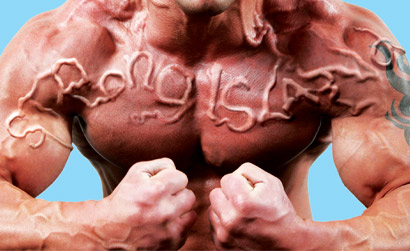
It wasn’t just his workout partner who noticed: A trainer at the gym who worked with bodybuilders spotted Drew and wanted to guide him to the next level. He was on board, but on two conditions. The first was a protein-dense proper diet. The second was a testosterone-dense improper diet.
“I said, ‘And ultimately, if you really want me to compete, I’d have to go on steroids.’ And I waited for his response, and he said, ‘Well, I know who I would send you to for that,’” Drew says. “I was really surprised, I mean, he’s a judge in all the competitions in the [area] and trains male and female bodybuilders and I thought he would play dumb with me, but he just said, ‘I know who I would send you to.’”
Drew ultimately balked at the prospective growth, but admits the offer was tempting. His side-effects were minimal, but growing: After 18 months of using, climbing stairs put him out of breath. His blood pressure also started to rise. It wasn’t organ failure or a sudden disease that put his steroids use out of commission; it was a nosebleed. But where most nosebleeds last minutes, his lasted days—seven of them. After a week of visits to emergency rooms, it finally stopped.
Spending a week with your head tilted back and tissue stuffed up your nose is by no means tame, but on the spectrum of steroids horror stories, it has some serious competition.
“I have a friend of mine, he went from 140 pounds to about 265 pounds—just a pure monster,” says Rhys*, a 23-year-old bodybuilder from Huntington with a shaved head, pierced tongue and 8 percent body fat. “He would stick [the needle] into his chest, he would stick it into his abs, he would stick it into his biceps—whatever he worked out that day he stuck. One time when he stuck it into his chest, he actually had to go to the hospital because [his chest] swelled up so bad he actually couldn’t breathe. For him it was all about results. It was about being as big as possible, and for him the ramifications of things just weren’t there. He just didn’t care.”
Take Two And Call Me In The Morning
For all the wild sensationalism and conjecture that has made steroids a household word, not much is really known about them. Categories, makeup, formulation, acceptable doses, side-effects—ask 10 people and you’ll wind up with 10 different answers.
The variety that rings the most bells is corticosteroids. They are a type of steroids our bodies naturally produce when under stress or in the fight-or-flight mindset. Synthesized versions are often used as a medically sanctioned treatment for rheumatoid arthritis, inflammation and auto-immune disorders.
“I had some kind of an inflammation, and when I went to my doctor he basically told me there are two ways we can go about it: One is to let the inflammation run its course and just wait, and the other is to fight it with some steroids,” says Barack Levin, a stay-at-home dad, parenting expert and author of the blog The Diaper Chronicles, who discovered he had an underlying kidney disease preventing the organs from filtering his blood. He was prescribed the pill prednisone, one of the most common synthesized corticosteroids, with instructions to take 60 mg each day and decrease the dosage by 5 mg every other week.
Corticosteroids—particularly prednisone—have a host of side-effects, says Dr. Kamau Kokayi, senior staff physician at Patients Medical, a holistic medicine center in Manhattan. Weight gain, sporadic fat deposits, increased blood pressure, cataracts, diabetes, unprovoked bruising, osteoporosis and widespread infection are just a few. It’s not so much will you see side-effects as it is which ones you’ll see.
“I remember it like it was yesterday—the first day I took the steroids; I kept asking [my doctor], ‘What are going to be the side-effects?’ and he told me, ‘You’re going to feel a little bit hyper. Other than that, you shouldn’t have any other problems,’” Levin says. “The first day I felt like I was on fire. I felt like I had tons of energy, [like] I could move mountains; basically I was an iron man. I could do whatever I wanted. I felt more alive than before; I felt like a Superman. I didn’t sleep the whole night.”
Fearing long-term damage to his kidneys, he decided to continue with the medication. After a day in Superman’s shoes, it might be hard to guess what side-effects day two would bring. Strangely enough, he spent more time as a member of the Justice League, this time as Aquaman.
“My saliva started to become salty, so just imagine every time you’re awake, you have salty water—like ocean water—in your mouth. I lost all sense of taste; everything tasted like nothing to me. The sensation of having salty saliva all the time drove me nuts. I called my doctor because I thought it was very, very weird and told him, ‘Listen, these are the side-effects I’m getting, I need to know if this is normal or not.’ And he immediately told me to stop the steroids on the spot.”
Levin’s doctor told him the effects he was seeing were consistent with total renal failure; the organ he was trying to save was actually being killed. He spent a month without any corticosteroids and saw his kidneys recover from the state they’d been put in by the 60 mg dosage, but the inflammation persisted. Levin began a less intense prednisone treatment—40 mg, taken every other day. The steroids returned, and so did the bizarre side-effects: Superman-like power (“Like I had lava flowing in my blood”), constant shaking and trembling (“I couldn’t hold a spoon—almost to the point of Parkinson’s”), near-schizophrenia (“It’s like three or four different me’s were thinking different thoughts at the same time”), mood swings (“If you ever wanted to know how a woman feels when she is on her period…”) and the feeling his skin couldn’t hold his inner being (“If you think about The Nutty Professor…”).



